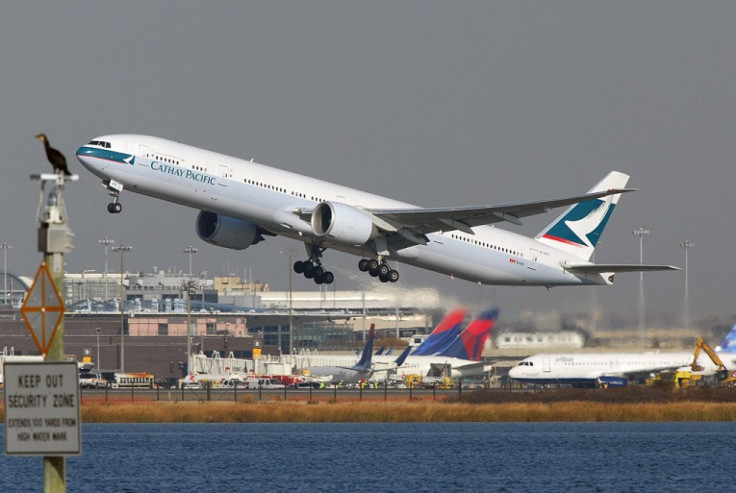Snowy Owls Shot At JFK: Port Authority Mulls Alternatives To Control Birds At NY Airports

A certain kind of holiday traveler is finding a very cold welcome in New York City. Three snowy owls were reportedly shot and killed at John F. Kennedy International Airport this past Saturday, according to the Los Angeles Times.
While the Port Authority of New York and New Jersey hasn’t confirmed the kills, it did offer a justification for adding snowy owls to its “kill list.”
“Over the past two weeks, five planes at JFK, Newark Liberty and LaGuardia airports were struck by snowy owls that have been migrating to our region in far higher than typical numbers this year,” the agency said in a statement on Monday.
The danger posed by birds to airplanes and their passengers is very real: In 2009, US Airways Flight 1549 struck a flight of geese and lost engine power (though all aboard were saved by pilot Chesley Sullenberger, who managed to set the plane down on the Hudson River). The Federal Aviation Administration has recorded more than 100 wildlife strikes at JFK airport and 66 strikes at La Guardia Airport so far this year -- mostly birds, but with the occasional bat thrown in. Part of the reason JFK is so plagued by birds is that it lies right next to a national bird sanctuary: the Jamaica Bay Wildlife Refuge.
But, prompted by media reports on the slain owls, the Port Authority now says it is going to work with the state’s environmental conservation department to implement a trapping and relocation program.
“The Port Authority’s goal is to strike a balance in humanely controlling bird populations at and around the agency’s airports to safeguard passengers on thousands of aircrafts each day,” the agency said.
There really are a lot of snowy owls flocking to New York this year, according to Cornell University ornithologist Kevin McGowan, an owl specialist. When a bird shows up in an area that it doesn’t normally frequent, birders call that an irruption.
With snowy owls, “it’s an irruption year of this unpredictable arctic bird,” McGowan wrote in an email. “Periodically they come out of the far, frozen north and delight bird watchers in the northern states and southern Canada. This is shaping up to be one of the largest irruptions we have seen in the Northeast.”
Is climate change to blame for this particular crop of owls hanging out at JFK? Probably not, McGowan says.
“Although we are concerned about climate change effects on such high-arctic birds, this event is likely the result of local conditions in part of the range, and is not unprecedented,” he wrote.
Maybe it’s time to bring back a group of longtime JFK employees: trained falcons. Since the mid-1990s, the airport contracted the services of raptors to scare off birds from the runway. But the birds and their handlers were abruptly given pink slips in 2011 as a measure to cut costs.
"Falconry is just expensive," Martin Lowney, director of the U.S. Department of Agriculture's wildlife-control service for New York state, told the Wall Street Journal at the time. "Compared to falconry, shooting is more economical and more effective."
Many wildlife experts, however, say that falcons are better at training other birds to avoid airport areas.
“A falcon guarantees results every time,” Mark Adam, owner of Falcon Environmental Services, an Ontario-based company that provided falcons for JFK, told Wired in 2011. “The local birds know that our animals are eaters and they’re going to be lunch.”
But are falcons as effective against all kinds of birds? A Port Authority spokesman told the New York Daily News in 2009 that falcons are fine for scaring gulls, but don’t work against geese -- hence the agency's use of falcons at JFK, but not La Guardia, he said. Biologists, on the other hand, argue that falcons are fearsome enough to drive off everything but other raptors and vultures.
Peregrine falcons are quick and deadly, but relatively small -- anywhere from 13 to 23 inches long, and weighing up to 3.3 pounds -- compared with the snowy owl, which can reach up to 28 inches and more than 6 pounds. In 2012, birders in Illinois captured a face-off between a snowy owl and a peregrine falcon in the wild that basically ended in a draw. So there’s no guarantee that owls would be scared off as easily as the littler birds that falcons make a meal of.
Another method for keeping birds away from airports involves getting your hands a little dirty. Australian researchers recently visited Perth Airport and collected 77 bird carcasses for genetic analysis. But the target wasn’t the birds themselves; it was their their poop -- or rather, pre-poop. The researchers extracted and analyzed the DNA from the mishmash of material inside the birds’ intestines, in order to figure out what the birds were eating. If airports can deduce what birds around airports are feeding on, they may be able to eliminate the plants and rodents that are drawing them.
Owls and geese aren’t the only animals that have felt the ire of the Port Authority. In 2007, the agency began trapping feral cats lurking in the cargo areas of JFK. Why? The authorities worried that the cats’ food, left by sympathetic airport employees, would attract birds.
© Copyright IBTimes 2024. All rights reserved.





















